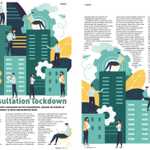This time two weeks ago a development director of a leisure company might have been running or contributing to a consultation event for a proposed scheme – providing there was enough hand sanitizer to go round.
But what a difference a fortnight makes. Today all leisure facilities are closed, public meetings are banned and most work is taking place from home.
This is the time for focussing on those areas of the development process which can continue in this unprecedented situation. It’s also an opportunity to find new ways of doing things which enable progress to be made.
In planning the early stages of a scheme, community consultation is vital. It is not just a legal requirement, but an opportunity for the community and the developer to exchange insight that will genuinely benefit the scheme, as well as gaining community support early on. While exhibitions and community meetings are off the agenda for the moment, their absence can be met by online consultation, which is inexpensive and easy to put in place. And with social activities cancelled and people in lockdown, the audience is ready and waiting.
There are many reasons why developers increasingly choose to use online consultation:
- Research: The internet is by far the most powerful research resource. A substantial proportion of information that is required in researching stakeholder groups and necessary background information is freely and readily available.
- Issues management: A constructive consultation is based on the community having access to reliable information, which can be easily sourced online. Monitoring of online consultation provide an immediate and effective means of understanding local sentiment and identifying any misapprehensions.
- Immediacy: Online consultation has the advantage of being immediate: information can be posted and responded to in minutes. But consultation timelines should not be shortened as a result. On the contrary, immediate communication can only take place if the audience has been targeted and is in receipt of the message. Online communication can potentially spread quickly but only if the message is strong and compelling.
- Ease of access: Online communication is a medium in which many people choose to communicate and by targeting residents via their preferred means, the likelihood of involvement is increased. Users can take part in an online consultation when and where they want – at home, on the move. Many chose to do so late at night. Because of its increased accessibility, online consultation has the power to reach new audiences – particularly the young and the time-poor. Local authorities welcome developers’ inclination to consult more widely; simultaneously this enables developers to unearth the support of the ‘silent majority’.
- Dialogue: Online consultation allows for real-time dialogue and an exchange of ideas on a one-to-one, one-to-many and many-to-many basis.
- Removing hierarchies: Online consultation has no regard for the limiting social stratas that we impose on ourselves. In a busy public meeting, for example, attendees may defer to a dominating character or group leader. Ultimately those members are not adequately represented, despite their presence. Online, and particularly behind the veil of a username, individuals are more likely to voice opinions without fear of repercussions, while personal details remain confidential but are accessible to the local authority as a confidential appendix to the consultation report.
- Reaching ‘hard to reach’ groups: Many people – particularly commuters, families with young children, the elderly and disabled – are not easily able to attend consultation events. Online consultation provides an alternative, accessible means of engagement. Online consultation can be accessible in both its language and in the varied ways in which information is presented.
- Promotion: Social media, blogs and the local media online can assist in communicating messages quickly.
- Moderation: Both websites and social media can be monitored effectively. The way in which a consultation is to be moderated should be determined at the start and ideally communicated via a user guide to ensure consistency. For example, it should be decided in advance whether user generated content is to be vetted before appearing and if so, on what basis comment might be withdrawn.
- Analysis: Online communication can be very effectively analysed: comprising day-by-day website usage; average session times and bounce rates; analysis of the most popular pages; demographic information in relation to location, gender, age and interest; analysis of how people are reaching the website; results per poll / forum / survey / blog comment; maps to depict the location of respondents. Likewise qualitative analysis which combines a technical and human approach can be more sophisticated than offline analysis.
- Feedback: A consultation website, email and social media provide ideal means for communicating feedback.
Using online consultation can help us to keep the industry moving and avoid job losses. And its many advantages mean it can run successfully alongside an offline consultation, providing the ideal package for genuine engagement.
This article was first published in Leisure Design & Build in April 2020.
END
Penny Norton is the director of PNPR and runs ConsultOnline, on online consultation service. Her book Public Consultation and Community Involvement in Planning: a twenty-first century guide was published by Routledge in 2017 and Promoting Property: insight, experience and best practice was published by Routledge in April 2020.
